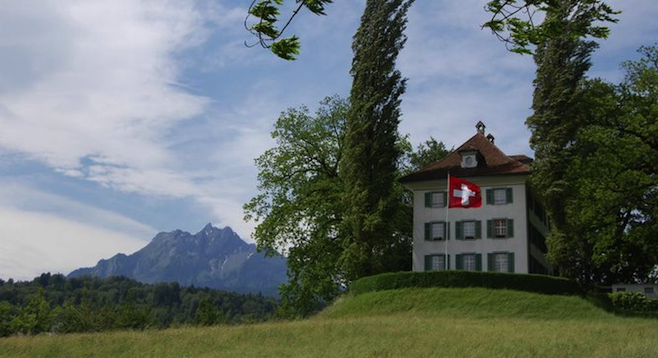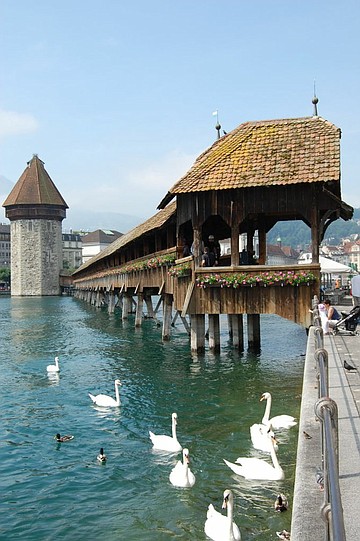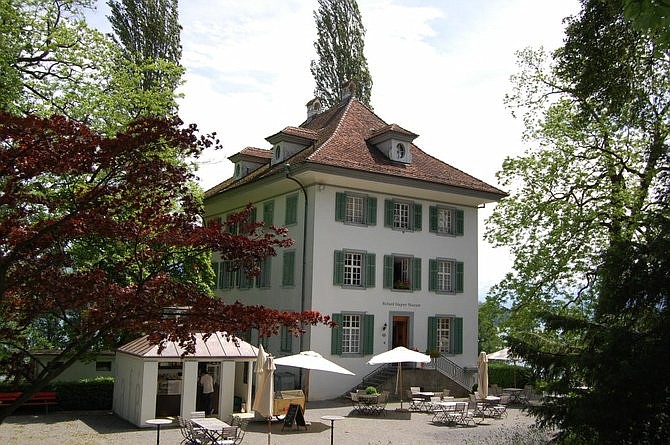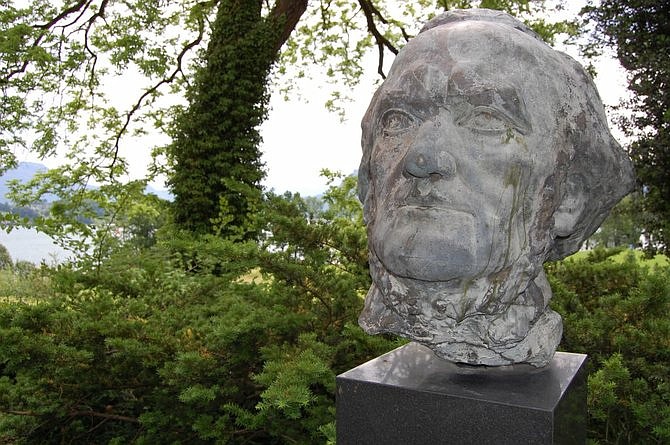 Facebook
Facebook
 X
X
 Instagram
Instagram
 TikTok
TikTok
 Youtube
Youtube

May 22 is the bicentennial of the birth of German composer Richard Wagner. Although born 1813 in Leipzig, the operatic genius has a strong connection to Switzerland. Wagner – then Royal Saxon Court Conductor – supported Germany’s democratic movement against the monarchists, hobnobbed with anarchist Mikhail Bakunin and was involved in the Dresden Uprising. Like in Les Miserables, the people went to the barricades, but were defeated; the old opera house was burned down. With a warrant issued for his arrest, Wagner went into exile in Switzerland.

Wagner first lived in Zürich from 1849 to 1858; however, after being permitted to return to Germany, he fell into disfavor and was exiled again, settling from 1866 to 1872 in Lucerne. This splendid, sparkling Swiss city of 60,000 is famous for Kapellbrücke (Chapel Bridge) – a medieval wooden covered bridge decorated with centuries’ old paintings and attached to a water tower – that spans the River Reuss, linking the Old Town.
Lucerne (Luzern in Swiss German) is remembering its adopted son and celebrating Wagner’s 200th anniversary through November 30.
The composer lived in a three-story mansion perched near exquisite Lake Lucerne and surrounded by dramatic Alpine vistas. It’s now a showplace for all things Wagnerian. The Richard Wagner Museum documents and celebrates Wagner’s music and life in Switzerland and is participating in the musician’s bicentennial commemorations.

Originally built in the 15th century, this manor was owned by Lt. Col. Walter Am Rhyn when Wagner stumbled upon while sailing across Lake Lucerne in 1866. Today, visitors can take the boat Rütli from Bahnhofquai (the dock near Lucerne’s main train station) April through October to Wagner’s former home.
Alternatively, ride the number 6, 7 or 8 bus from Lucerne’s Bahnhof for six stops, less than two miles south of the city center, to the Wartegg stop. From there, follow street signs, walk almost 10 minutes towards Lake Lucerne and then up an incline to the sole house at the shady green enclave called Tribschen.

At the grounds’ entrance is the outdoor Sommercafé, offering superb lake and mountain views plus espresso, wine, beer, cake, panini and salad. On the café’s right, a larger-than-life stone bust of a determined-looking, mutton-chopped Wagner is mounted on a pedestal (left).
Stirring Wagnerian horn music plays as guests enter the inner sanctum, where Wagnerana is mounted on walls or ensconced in glass cases around the five-room first floor. Numerous oil and photo portraits depict the usually stern-looking composer. In one black-and-white print, a youthful Wagner almost smiles.
The imagery includes fanciful paintings portraying gods, giants, dwarves, warriors and Valkyries from various Wagner works at their mythic settings. There is a triptych of The Ring of the Nibelung’s legends, as well as Black Forest–born symbolist painter Hans Thoma’s four aquarelles and pastels visualizing Nibelungen characters, such as the Rhine maidens, Brunnhilde, and Siegfried. There are also photos of 19th-century sopranos, tenors, etc., who incarnated various Wagner dramatis personae onstage.
The death masks of not only Wagner, but of philosopher Friedrich Nietzsche, a frequent Tribschen houseguest, are also displayed. Like Wagner, Nietzsche was a European exile living in Switzerland whose work was later misappropriated and exploited by the Third Reich for propagandistic purposes. Another objet d’art is a plaster cast of the hand of Wagner, also a conductor and pianist.

The permanent collection appropriately includes manuscripts of books he wrote, composition books, librettos, scores and sheet music, plus musical instruments – notably Wagner’s Erard grand piano from Paris, which the museum’s website calls its “gem.” A tuba and Swiss alpenhorn are also exhibited, the latter suggesting Wagner’s affection for his adopted homeland.
Wagner so loved Switzerland that he used the alpenhorn, a traditional Swiss folk instrument, in Tristan and Isolde, incorporating a melody he’d heard played on the long wooden open pipe instrument at Mt. Rigi to conjure a herdsmen’s dance.
A confirmed Alpenist, Wagner traveled around the mountainous nation ascending the Alps, especially in the central region, where Lucerne is. Two of his favorite mountains are visible from Tribschen: Mt. Pilatus towers behind the mansion; Mt. Rigi looms across Lake Lucerne.
When I visited the museum, its special exhibit on the second floor through November 30 (when the shrine closes until March), “Alpine Myth in the 19th Century: Richard Wagner Walks in Switzerland,” honored the master’s “fascination with high mountains,” where he could imagine his legendary Nordic characters and creatures carrying out their derring-do at dreamy, far-off Valhallas.
Back downstairs, I chatted with curator Katja Fleischer, a young German woman who’d studied at Wagner’s birthplace, Leipzig. Fleischer said she was “a musicologist, not a musician,” and that “Wagner is my favorite composer. It’s important – I work here… for [11] years.” Her favorite work by the maestro is Tristan and Isolde; in 1859 Wagner completed its score while living at Hotel Schweizerhof, which still stands lakeside at Lucerne.
The same year Wagner married Cosima (Franz Liszt’s daughter) at Lucerne’s St. Matthew’s Church, he composed Siegfried’s Idyll. On his Tribschen home’s steps, he awakened his new wife with a birthday-present premiere in 1870. In 1938, Arturo Toscanini – who spurned the Wagner-originated Bayreuth Festival then held in Nazi Germany – conducted Siegfried’s Idyll at Tribschen. Broadcast live in America by NBC, the Lucerne Festival was born.
Wagner’s 200th birthday observances would be incomplete without musical celebrations. The Tribschen Chamber Music Festival takes place May 21 through June 30, first at Hotel Schweizerhof, then at the Wagner Museum, and includes the world premiere of two museum-commissioned works to commemorate the anniversary. Compositions by Swiss artist Andres Bosshard called Tribschen Island of Sound can be heard at Tribschen Park through November 30.
August 30–September 4, the Lucerne Festival presents the Ring Cycle at the acoustically perfect KKL. The Kultur und Kongresszentrum Luzern (Culture and Convention Center Lucerne) has a distinctive overhanging roof stretching towards the lake and is near Kapellbrücke (left) – which, like Brunnhilde, survived fire. A fitting symbol for the idyllic city Wagner loved and found refuge in 150 years ago.
Long after his 1883 death, Wagner became the Third Reich’s musical poster boy. In a new documentary called Wagner & Me, narrator Stephen Fry (Sherlock Holmes’ brother Mycroft in the Robert Downey, Jr. film franchise) insists we mustn’t allow Hitler to claim Wagner.
Hopefully the bicentennial tributes in peaceful, neutral Switzerland, which hasn’t experienced war since Wagner first arrived there, can assist in that process.


May 22 is the bicentennial of the birth of German composer Richard Wagner. Although born 1813 in Leipzig, the operatic genius has a strong connection to Switzerland. Wagner – then Royal Saxon Court Conductor – supported Germany’s democratic movement against the monarchists, hobnobbed with anarchist Mikhail Bakunin and was involved in the Dresden Uprising. Like in Les Miserables, the people went to the barricades, but were defeated; the old opera house was burned down. With a warrant issued for his arrest, Wagner went into exile in Switzerland.

Wagner first lived in Zürich from 1849 to 1858; however, after being permitted to return to Germany, he fell into disfavor and was exiled again, settling from 1866 to 1872 in Lucerne. This splendid, sparkling Swiss city of 60,000 is famous for Kapellbrücke (Chapel Bridge) – a medieval wooden covered bridge decorated with centuries’ old paintings and attached to a water tower – that spans the River Reuss, linking the Old Town.
Lucerne (Luzern in Swiss German) is remembering its adopted son and celebrating Wagner’s 200th anniversary through November 30.
The composer lived in a three-story mansion perched near exquisite Lake Lucerne and surrounded by dramatic Alpine vistas. It’s now a showplace for all things Wagnerian. The Richard Wagner Museum documents and celebrates Wagner’s music and life in Switzerland and is participating in the musician’s bicentennial commemorations.

Originally built in the 15th century, this manor was owned by Lt. Col. Walter Am Rhyn when Wagner stumbled upon while sailing across Lake Lucerne in 1866. Today, visitors can take the boat Rütli from Bahnhofquai (the dock near Lucerne’s main train station) April through October to Wagner’s former home.
Alternatively, ride the number 6, 7 or 8 bus from Lucerne’s Bahnhof for six stops, less than two miles south of the city center, to the Wartegg stop. From there, follow street signs, walk almost 10 minutes towards Lake Lucerne and then up an incline to the sole house at the shady green enclave called Tribschen.

At the grounds’ entrance is the outdoor Sommercafé, offering superb lake and mountain views plus espresso, wine, beer, cake, panini and salad. On the café’s right, a larger-than-life stone bust of a determined-looking, mutton-chopped Wagner is mounted on a pedestal (left).
Stirring Wagnerian horn music plays as guests enter the inner sanctum, where Wagnerana is mounted on walls or ensconced in glass cases around the five-room first floor. Numerous oil and photo portraits depict the usually stern-looking composer. In one black-and-white print, a youthful Wagner almost smiles.
The imagery includes fanciful paintings portraying gods, giants, dwarves, warriors and Valkyries from various Wagner works at their mythic settings. There is a triptych of The Ring of the Nibelung’s legends, as well as Black Forest–born symbolist painter Hans Thoma’s four aquarelles and pastels visualizing Nibelungen characters, such as the Rhine maidens, Brunnhilde, and Siegfried. There are also photos of 19th-century sopranos, tenors, etc., who incarnated various Wagner dramatis personae onstage.
The death masks of not only Wagner, but of philosopher Friedrich Nietzsche, a frequent Tribschen houseguest, are also displayed. Like Wagner, Nietzsche was a European exile living in Switzerland whose work was later misappropriated and exploited by the Third Reich for propagandistic purposes. Another objet d’art is a plaster cast of the hand of Wagner, also a conductor and pianist.

The permanent collection appropriately includes manuscripts of books he wrote, composition books, librettos, scores and sheet music, plus musical instruments – notably Wagner’s Erard grand piano from Paris, which the museum’s website calls its “gem.” A tuba and Swiss alpenhorn are also exhibited, the latter suggesting Wagner’s affection for his adopted homeland.
Wagner so loved Switzerland that he used the alpenhorn, a traditional Swiss folk instrument, in Tristan and Isolde, incorporating a melody he’d heard played on the long wooden open pipe instrument at Mt. Rigi to conjure a herdsmen’s dance.
A confirmed Alpenist, Wagner traveled around the mountainous nation ascending the Alps, especially in the central region, where Lucerne is. Two of his favorite mountains are visible from Tribschen: Mt. Pilatus towers behind the mansion; Mt. Rigi looms across Lake Lucerne.
When I visited the museum, its special exhibit on the second floor through November 30 (when the shrine closes until March), “Alpine Myth in the 19th Century: Richard Wagner Walks in Switzerland,” honored the master’s “fascination with high mountains,” where he could imagine his legendary Nordic characters and creatures carrying out their derring-do at dreamy, far-off Valhallas.
Back downstairs, I chatted with curator Katja Fleischer, a young German woman who’d studied at Wagner’s birthplace, Leipzig. Fleischer said she was “a musicologist, not a musician,” and that “Wagner is my favorite composer. It’s important – I work here… for [11] years.” Her favorite work by the maestro is Tristan and Isolde; in 1859 Wagner completed its score while living at Hotel Schweizerhof, which still stands lakeside at Lucerne.
The same year Wagner married Cosima (Franz Liszt’s daughter) at Lucerne’s St. Matthew’s Church, he composed Siegfried’s Idyll. On his Tribschen home’s steps, he awakened his new wife with a birthday-present premiere in 1870. In 1938, Arturo Toscanini – who spurned the Wagner-originated Bayreuth Festival then held in Nazi Germany – conducted Siegfried’s Idyll at Tribschen. Broadcast live in America by NBC, the Lucerne Festival was born.
Wagner’s 200th birthday observances would be incomplete without musical celebrations. The Tribschen Chamber Music Festival takes place May 21 through June 30, first at Hotel Schweizerhof, then at the Wagner Museum, and includes the world premiere of two museum-commissioned works to commemorate the anniversary. Compositions by Swiss artist Andres Bosshard called Tribschen Island of Sound can be heard at Tribschen Park through November 30.
August 30–September 4, the Lucerne Festival presents the Ring Cycle at the acoustically perfect KKL. The Kultur und Kongresszentrum Luzern (Culture and Convention Center Lucerne) has a distinctive overhanging roof stretching towards the lake and is near Kapellbrücke (left) – which, like Brunnhilde, survived fire. A fitting symbol for the idyllic city Wagner loved and found refuge in 150 years ago.
Long after his 1883 death, Wagner became the Third Reich’s musical poster boy. In a new documentary called Wagner & Me, narrator Stephen Fry (Sherlock Holmes’ brother Mycroft in the Robert Downey, Jr. film franchise) insists we mustn’t allow Hitler to claim Wagner.
Hopefully the bicentennial tributes in peaceful, neutral Switzerland, which hasn’t experienced war since Wagner first arrived there, can assist in that process.
Comments